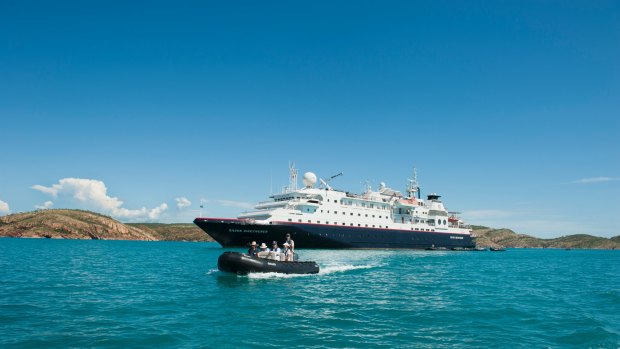This was published 6 years ago
Cruising The Kimberley and Horizontal Falls: Australia's most unusual natural wonder
By Andrew Bain
On the Kimberley coastline, the tide is turning. High tide has been, and now it's as though somebody has pulled the plug on the ocean. Millions of litres of ocean sucks through a narrow sea gorge, the water brawling and churning as it goes. And we're about to head through it in a boat.
Known as the Horizontal Waterfalls, this ocean phenomenon is the result of one of the world's highest tidal shifts compressing through two narrow breaks in the Kimberley coastline. Sir David Attenborough has called it "Australia's most unusual natural wonder", and 15 years ago noted that few people in the world had seen it.
Time has changed that, with the Horizontal Waterfalls now accessible on seaplane trips from Broome and Derby, and a standard stop on expedition cruises along the Kimberley coast.
I've come on Silversea's Silver Discoverer ship, which has anchored in Talbot Bay on our first full day out from Broome. Seemingly enclosed by hills, the bay looks and feels like a lagoon, with water that's almost the blue of a glacial lake.
In Talbot Bay we're met by a couple of different species of sea creature: a large tawny nurse shark that cruises placidly around the ship trailed by an entourage of reef sharks, and a 900-horsepower fast boat from Horizontal Falls Seaplane Adventures.
In the fast boat, we skim across the bay to the mouth of the Horizontal Waterfalls, where tides as high as 13 metres squish through two gorges with rust-red walls that are as close as seven metres apart.

Silversea's Silver Discoverer.
During the highest tides, as much as one million litres of water pours through the gaps every second. We've had the fortune (good or bad, depending on your perspective) to arrive on a neap tide of just four to five metres. The next few minutes are going to be like a dress rehearsal of the full natural fury that can occur here.
"This is the most dangerous current in the Kimberley," the skipper, Adrian, announces. And with that, we're going in, bouncing across the water like a vehicle on a corrugated desert track. In the middle of the gap, Adrian slows the boat and then suddenly we're idling, as though we're gently parking in the middle of a storm.
"The water's running at 12km/h here," he reads from the boat's gadgetry, but this is the widest and most placid of the two gaps. By the time we're idling again inside the narrower gorge, less than a kilometre ahead, the water's flooding through at 23km/h. When we turn and head back through the gorge, travelling with the flow, it's like being sucked through a straw, the water surging so fast it's literally flowing downhill, creating a step of water at the end of the gorge.
Today the step is just half a metre in height, which is daunting enough when you're about to plunge over it, but when it gets above one or two metres, boats can't get through, the angle of the step stranding their motors out of the water.
Incredibly, there's a force around Talbot Bay even more powerful than the Horizontal Waterfalls. In the afternoon, we board the Silver Discoverer's zodiacs and head to the bay's end, funnelling into Cyclone Creek.
As the eyes of a crocodile roll past like marbles, we head upstream and into the sort of prehistory that's beyond comprehension. The Kimberley was once separated from the rest of Australia, and Cyclone Creek is pretty much along the line where the two landmasses are thought to have collided.
Above the river, the towering orange cliffs bristle with spinifex, and there are ramparts of rock that look like defensive walls constructed by humans – the Great Wall of Australia.
As we edge in closer to the cliffs, their most striking feature becomes apparent. These rocks said to be 1.7 billion years old – almost half the age of the Earth – are bent, buckled and scrunched up like paper, testifying to the cataclysmic force that shaped them when the lands came together. Against this, even the Horizontal Waterfalls seem like a gentle brook.
TRIP NOTES
MORE
FLY
Qantas has direct flights from Sydney and Melbourne to Broome and Darwin, the start and finish ports of the Silver Discoverer cruise. qantas.com
CRUISE
The Silver Discoverer will operate between Broome and Darwin from July to August 2018. All-inclusive cruise and air package fares on the 10-day expedition trip begin from $11,340. silversea.com
Andrew Bain travelled courtesy of Silversea.
See also: Stunning photos of the Kimberley's record-breaking wet
See also: The Australian luxury lodge on the edge of the world
Sign up for the Traveller Deals newsletter
Get exclusive travel deals delivered straight to your inbox. Sign up now.